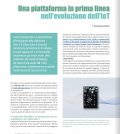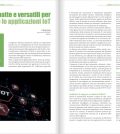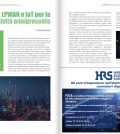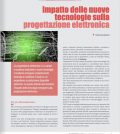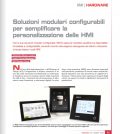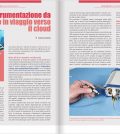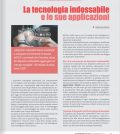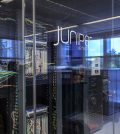EONews Virtual Panel – Internet of Things (IoT): market opportunities in the smart devices
An exclusive interview with Jens Wiegand, vice president and general manager, strategic marketing, Wind River

EONEWS: The emerging trend of the “Internet of Things” (IoT), of endpoints and connected intelligent devices in both industrial and civil environments, is now progressively introducing more automation and quality in the product and electronic systems lifecycle management. From your point of view, which could be the new market opportunities related to the smart devices and the ‘ambient intelligence’?
WIEGAND: The Internet of Things is transforming not only businesses, but also our lives. The ability of connected intelligent devices to perceive and respond to the environment around them makes them incredibly valuable for complex decision-making in a broad range of industries. The momentum behind the Internet of Things derives from macroeconomic trends, as well as trends that impact specific industries or groups of adopters.
Some of the key benefits associated with smart devices and the ‘ambient intelligence’ include the following areas summarized below:
- Reduction of high labour costs. It typically costs at least three times as much for a human to perform a task as a machine. Intelligent systems can now perform many tasks that require intelligence and situational awareness, such as utility meter reading, smart building monitoring, power management, and so on.
- Productivity by leveraging adoptive analytics. Data has become the new currency of business, and intelligent systems can supply both the raw material and sophisticated, real-time analytics that shape and guide more intelligent business decisions resulting in a gain of productivity.
- New business models and revenue streams. Intelligent systems can be both an on-ramp to the cloud and a means of exploiting the cloud’s potential. Through intelligent systems’, businesses can develop new services and offer them through the Software-as-a-Service (SaaS) model, creating new efficiencies and economies.
- Eco considerations. Machines can perform power management tasks with finer precision and faster response times than manual, human-dependent systems—saving energy, prioritizing usage, setting policies for response to outages, etc.
- The “instant gratification” culture. Customers want everything now—whether it’s just-in-time servicing, real-time order fulfilment, or immediate answers to complex questions. Intelligent systems can accelerate many services—and in the process accelerate revenue generation, higher profitability and new ways to monetize.
EONEWS: The Internet of Things may represent a new opportunity for business, but also a potential security threat. Which is your opinion on IoT-related danger (which may increase threats in industrial environments, but not only)?
WIEGAND: This starts with understanding the specific security vulnerabilities related to the device, data, services, applications, and management. Because we’re dealing with connected devices, an end-to-end security view is important from the device to the data center to IT and everything in between. A defense in depth approach with products, services and partners is critical.
Highly distributed architectures represent in general a larger challenge on device protection or privacy of data, and IoT serves as an accelerator in that regard. Providing tightly integrated, state of the art end device security capabilities for protecting devices and their data, but at the same time allowing for an end-to-end protection strategy will be a challenge for many IoT adopters.
The following are key security considerations:
- Complexity and customization requirements: The technologies involved in creating secure intelligent systems are extremely broad and complex, and most solutions don’t provide a seamless secure end-to-end experience between the business backbone and the system or device domain, thus must be customized to some degree.
- Lack of specialized skills and expertise: The skill sets required to build secure intelligent devices, as well as the requisite post deployment security strategies, typically reside outside the core competency of operators and device manufacturers.
- Slowly evolving security standards in technology or application deployment: The core components of intelligent systems have often been implemented in an ad-hoc fashion, using multiple competing standards in development and deployment. Often those standards represent significant security risk vectors which are not know, or worst case no risk management is applied at all. In addition, we still see the “impeding battle at the edge” between embedded and enterprise security standards when it comes to the adoption of IoT concepts.
A cura della redazione
Contenuti correlati
-
Una piattaforma in prima linea nell’evoluzione dell’IoT
I livelli di produttività e le caratteristiche all’avanguardia della piattaforma Serie 3 di Silicon Labs di prossima introduzione permetteranno lo sviluppo di nuove applicazioni e di funzionalità innovative nei più diversi settori, dalla produzione alla vendita al...
-
Antenne compatte e versatili per migliorare le applicazioni IoT
La scelta dell’antenna giusta può rivestire un’importanza fondamentale per il successo di un’applicazione IoT (Internet of Things) wireless. Un’antenna in grado di offrire prestazioni elevate e la flessibilità necessaria per supportare reti differenti può contribuire a migliorare...
-
5G, LPWAN e IoT per la connettività onnipresente
In questo articolo viene descritta la necessità di una connettività che sia presente in ogni luogo sfruttando le tecnologie 5G, LPWAN e IoT. Inoltre, vengono descritti sinteticamente i capisaldi dell’architettura della rete 5G, della rete LPWAN e...
-
Impatto delle nuove tecnologie sulla progettazione elettronica
La progettazione elettronica è un campo in continua evoluzione e nuove tecnologie e tendenze emergono costantemente destinate a modellare il modo in cui progettiamo e produciamo dispositivi elettronici. In questo articolo descriveremo l’impatto delle tecnologie emergenti sulla...
-
Una nuova iniziativa per l’interoperabilità per l’IoT industriale
Si chiama Margo la nuova iniziativa per fornire interoperabilità per gli ecosistemi IoT industriali nata dalla collaborazione tra ABB (inclusa B&R), Capgemini, Microsoft, Rockwell Automation, Schneider Electric (inclusa AVEVA) e Siemens. Questa iniziativa è ospitata dalla Linux...
-
Monitoraggio dei processi industriali con il microcontrollore ESP32
Un sistema di monitoraggio dei processi industriali è molto utile per la piccola e media industria per ottenere il massimo rendimento della produzione ed evitare guasti ai macchinari e incidenti. Un sistema di monitoraggio e sicurezza semplice...
-
Soluzioni modulari configurabili per semplificare la personalizzazione delle HMI
Con le sue soluzioni modulari configurabili, SECO assicura il perfetto equilibrio tra disponibilità immediata e configurabilità, venendo incontro alle esigenze eterogenee dei clienti e riducendo al tempo stesso i costi NRE Leggi l’articolo completo su EMB92
-
La strumentazione da laboratorio in viaggio verso il cloud
La tendenza è chiara: il software assume un ruolo sempre più importante nelle misurazioni. E anche se per il momento si è ancora lontani dall’aver trovato applicazioni che sostituiscano gli strumenti più evoluti, miniaturizzazione, connettività IoT e...
-
La tecnologia indossabile e le sue applicazioni
I dispositivi indossabili hanno contribuito a sviluppare enormemente l’industria dell’IoT e si prevede che l’industria stessa dei dispositivi indossabili raggiungerà nel mercato mondiale i 100 miliardi di dollari entro il 2027 Leggi l’articolo completo su EO 516
-
Samsung, Juniper Networks e Wind River collaborano per le reti vRAN e Open RAN
Samsung Electronics, Juniper Networks e Wind River hanno collaborato per lo sviluppo di un vCSR (virtual cell site router) che consente ai service provider di gestire le proprie reti con virtualizzazione end-to-end. Questo sistema fa parte di...


